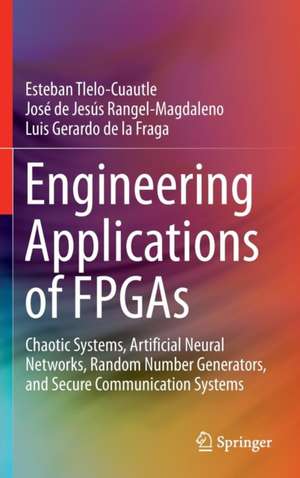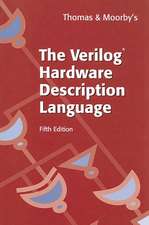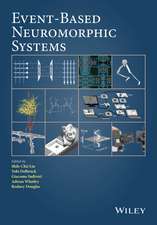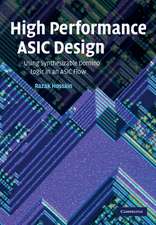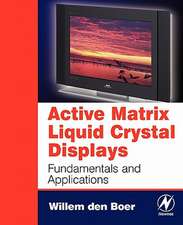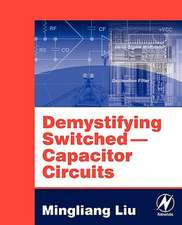Engineering Applications of FPGAs: Chaotic Systems, Artificial Neural Networks, Random Number Generators, and Secure Communication Systems
Autor Esteban Tlelo-Cuautle, José de Jesús Rangel-Magdaleno, Luis Gerardo de la Fragaen Limba Engleză Hardback – 3 iun 2016
Finally, optimized chaotic oscillators are synchronized and realized to implement a secure communication system that processes black and white and grey-scale images. In each application, readers will find VHDL programming guidelines and computer arithmetic issues, along with co-simulation examples with Active-HDL and Simulink. The whole book provides a practical guide to implementing a variety of engineering applications from VHDL programming and co-simulation issues, to FPGA realizations of chaos generators, ANNs for chaotic time-series prediction, RNGs and chaotic secure communications for image transmission.
| Toate formatele și edițiile | Preț | Express |
|---|---|---|
| Paperback (1) | 581.14 lei 6-8 săpt. | |
| Springer International Publishing – 30 mai 2018 | 581.14 lei 6-8 săpt. | |
| Hardback (1) | 784.48 lei 6-8 săpt. | |
| Springer International Publishing – 3 iun 2016 | 784.48 lei 6-8 săpt. |
Preț: 784.48 lei
Preț vechi: 956.68 lei
-18% Nou
Puncte Express: 1177
Preț estimativ în valută:
150.11€ • 157.15$ • 124.21£
150.11€ • 157.15$ • 124.21£
Carte tipărită la comandă
Livrare economică 05-19 aprilie
Preluare comenzi: 021 569.72.76
Specificații
ISBN-13: 9783319341132
ISBN-10: 3319341138
Pagini: 186
Ilustrații: XVI, 222 p. 204 illus., 130 illus. in color.
Dimensiuni: 155 x 235 x 14 mm
Greutate: 0.51 kg
Ediția:1st ed. 2016
Editura: Springer International Publishing
Colecția Springer
Locul publicării:Cham, Switzerland
ISBN-10: 3319341138
Pagini: 186
Ilustrații: XVI, 222 p. 204 illus., 130 illus. in color.
Dimensiuni: 155 x 235 x 14 mm
Greutate: 0.51 kg
Ediția:1st ed. 2016
Editura: Springer International Publishing
Colecția Springer
Locul publicării:Cham, Switzerland
Cuprins
Introduction to field programmable gate arrays.- VHDL.- Matlab-Simulink Co-simulation.- Chaos generators.- Artificial neural networks for time series prediction.- Random number generators.- Secure communication system.- Challenges in engineering applications.
Notă biografică
Esteban Tlelo-Cuautle received a B.Sc. degree from Instituto Tecnológico de Puebla México in 1993. He then received both M.Sc. and Ph.D. degrees from Instituto Nacional de Astrofísica, Óptica y Electrónica (INAOE) México in 1995 and 2000, respectively. From 2001 he is appointed as Tenure Professor at INAOE. He has authored or edited 13 books and more than 250 works published in book chapters, journals and conferences. He serves as Associate Editor in IEEE Transactions on Circuits and Systems I: Regular Papers (2016-2017), Integration - the VLSI Journal (2013-2016), and IEEE Transactions on Circuits and Systems II: Express Briefs (2014-2015). He has been Technical Program Committee member of major conferences in the areas of circuits and systems (CAS). His research interests include modeling, design and synthesis of integrated CAS, design and applications of chaotic systems, CAS optimization by heuristics, symbolic analysis and analog/RF and mixed-signal design automationtools.
Jose de Jesus Rangel-Magdaleno received the B.E. degree in electronics engineering and the M.E. degree in electrical engineering on hardware signal processing from Universidad de Guanajuato, Mexico in 2006 and 2008, respectively. He received the Ph.D. degree in mechatronics from the Universidad Autonoma de Queretaro, Mexico in 2011. He is currently Titular Researcher at the Electronics Department at INAOE, Mexico. He has authored 20 journal articles and 21 conferences papers. He is a member of the Mexican national research system (SNI), level 1. His research interests include FPGAs, signal and image processing, instrumentation and mechatronics.
Luis Gerardo de la Fraga received the B.Sc. degree from the Veracruz Institute of Technology, Mexico, in 1992, the M.Sc. degree from the National Institute of Astrophysics, Optics and Electronics, Mexico, in 1994, in Electrical Engineering; and the Ph.D. degree from the Autonomous University ofMadrid, Spain, in 1998 in Informatics Engineering. From 1998 to 2000, he was Assistant Professor in the Autonomous University of Morelos State, in Cuernavaca, Mexico. Since 2000, he is working as researcher scientist at Cinvestav in the Computer Science Department in Mexico City. His research interests include computer graphics, computer vision, image processing, optimization, network security, and he is very enthusiastic of open-source software and GNU/Linux systems. He has authored more tan fifty technical articles published in journals, book chapters, and international conference proceedings. Dr. De la Fraga is member of IEEE and ACM since 2005.
Jose de Jesus Rangel-Magdaleno received the B.E. degree in electronics engineering and the M.E. degree in electrical engineering on hardware signal processing from Universidad de Guanajuato, Mexico in 2006 and 2008, respectively. He received the Ph.D. degree in mechatronics from the Universidad Autonoma de Queretaro, Mexico in 2011. He is currently Titular Researcher at the Electronics Department at INAOE, Mexico. He has authored 20 journal articles and 21 conferences papers. He is a member of the Mexican national research system (SNI), level 1. His research interests include FPGAs, signal and image processing, instrumentation and mechatronics.
Luis Gerardo de la Fraga received the B.Sc. degree from the Veracruz Institute of Technology, Mexico, in 1992, the M.Sc. degree from the National Institute of Astrophysics, Optics and Electronics, Mexico, in 1994, in Electrical Engineering; and the Ph.D. degree from the Autonomous University ofMadrid, Spain, in 1998 in Informatics Engineering. From 1998 to 2000, he was Assistant Professor in the Autonomous University of Morelos State, in Cuernavaca, Mexico. Since 2000, he is working as researcher scientist at Cinvestav in the Computer Science Department in Mexico City. His research interests include computer graphics, computer vision, image processing, optimization, network security, and he is very enthusiastic of open-source software and GNU/Linux systems. He has authored more tan fifty technical articles published in journals, book chapters, and international conference proceedings. Dr. De la Fraga is member of IEEE and ACM since 2005.
Textul de pe ultima copertă
This book offers readers a clear guide to implementing engineering applications with FPGAs, from the mathematical description to the hardware synthesis, including discussion of VHDL programming and co-simulation issues. Coverage includes FPGA realizations such as: chaos generators that are described from their mathematical models; artificial neural networks (ANNs) to predict chaotic time series, for which a discussion of different ANN topologies is included, with different learning techniques and activation functions; random number generators (RNGs) that are realized using different chaos generators, and discussions of their maximum Lyapunov exponent values and entropies. Finally, optimized chaotic oscillators are synchronized and realized to implement a secure communication system that processes black and white and grey-scale images. In each application, readers will find VHDL programming guidelines and computer arithmetic issues, alongwith co-simulation examples with Active-HDL and Simulink.
Readers will benefit from this practical guide to implementing a variety of engineering applications from VHDL programming and co-simulation issues, to FPGA realizations of chaos generators, ANNs for chaotic time-series prediction, RNGs and chaotic secure communications for image transmission.
Readers will benefit from this practical guide to implementing a variety of engineering applications from VHDL programming and co-simulation issues, to FPGA realizations of chaos generators, ANNs for chaotic time-series prediction, RNGs and chaotic secure communications for image transmission.
Caracteristici
Provides a practical guide to implementing a variety of engineering applications using FPGAs Demonstrates use of FPGAs for real applications, such as chaotic noise generators, artificial neural networks, random number generators and secure communications for processing audio and images Includes VHDL programming guidelines and issues, along with co-simulation examples with Active-HDL and Simulink Includes supplementary material: sn.pub/extras
